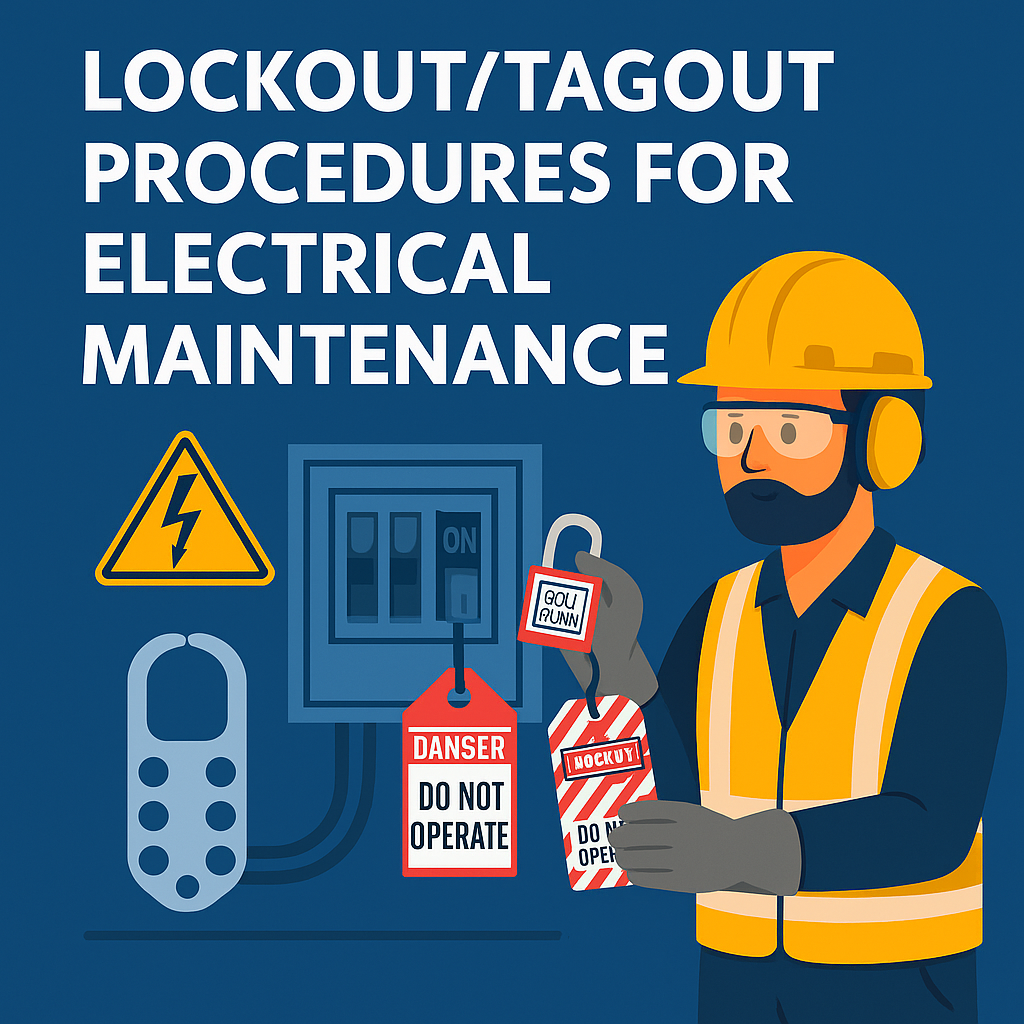
Lockout/Tagout LOTO Procedures for Electrical Maintenance
Electrical maintenance work involves significant risk, especially when equipment is not properly isolated from power sources. Many workplace accidents occur due to unexpected energization, stored electrical energy, or accidental startup of machinery. To eliminate these risks, workplaces use a structured system known as Lockout/Tagout (LOTO).
LOTO ensures that electrical systems and machinery are completely de-energized, locked, and tagged before maintenance begins. It is one of the most critical safety procedures in construction, industry, and facility management.
What Is Lockout/Tagout (LOTO)?
Lockout/Tagout is a formal safety procedure used to:
- Isolate equipment from energy sources
- Ensure machinery cannot start accidentally
- Protect workers during electrical maintenance
- Control stored or residual energy
Lockout
Applying a physical lock (padlock) to a device to prevent operation.
Tagout
Placing a warning tag to inform others that the equipment must not be operated.
LOTO is part of OSHA Standard 29 CFR 1910.147 — Control of Hazardous Energy.
Why LOTO Is Important in Electrical Maintenance
- Prevents accidental energization
- Protects workers from shock, electrocution, and arc flash
- Ensures safe maintenance and repair
- Avoids equipment damage
- Reduces downtime caused by accidents
- Ensures compliance with safety regulations
Types of Hazardous Energy Controlled by LOTO
Electrical Energy
Live circuits, capacitors, batteries, transformers.
Mechanical Energy
Rotating parts, moving belts, gears.
Thermal Energy
Heat sources, boilers.
Hydraulic & Pneumatic Energy
Pressurized lines or cylinders.
Chemical Energy
Stored energy in tanks or pipelines.
LOTO is not only for electrical systems—it applies to all forms of hazardous energy.
Basic Principles of LOTO
- Disconnect and isolate power
- Verify zero energy state
- Lock and tag equipment
- No worker removes another’s lock
- Device stays locked until the job is complete
Step-by-Step Lockout/Tagout Procedure for Electrical Maintenance
This section explains the standard 7-step LOTO procedure.
1. Preparation for Shutdown
Before performing LOTO:
- Identify all energy sources
- Review equipment manuals
- Understand risks and system layout
- Inform affected employees
Only authorized personnel can perform LOTO.
2. Equipment Shutdown
Turn off the equipment using normal shutdown procedures.
Steps may include:
- Switching off local controls
- Stopping motors
- Powering down panels
3. Isolation of Energy Sources
Disconnect electrical supply by:
- Opening circuit breakers
- Removing fuses
- Switching off disconnects
- Isolating control panels
For multi-energy equipment, isolate all sources (electrical, pneumatic, hydraulic, etc.).
4. Applying Lockout Devices
Attach:
- Lockout padlocks
- Hasps
- Breaker lockouts
- Valve lockouts
Each authorized worker attaches their own lock, ensuring personal control.
5. Applying Tagout Devices
Attach warning tags that include:
- Worker’s name
- Date/time
- Purpose of lockout
- Do Not Operate message
Tags increase visibility and communication.
6. Release or Control of Stored Energy
Stored energy must be removed or neutralized:
- Discharge capacitors
- Block moving parts
- Vent hydraulic or pneumatic lines
- Drain pressurized systems
Residual energy is a hidden hazard; always confirm it is released.
7. Verification of Zero Energy State
Before maintenance begins:
- Attempt to start the machine (test start)
- Use testing instruments to confirm de-energization
- Check voltage indicators or meters
- Ensure no movement or activity
Verification is the most critical step of LOTO.
LOTO Equipment Used in Electrical Maintenance
Lockout Devices
- Padlocks
- Lockout hasps
- Circuit breaker lockouts
- Plug lockouts
- Switch lockouts
Tagout Devices
- Warning tags
- Danger tags
- Permit tags
Verification Tools
- Multimeter
- Test lamps
- Voltage detectors
Other Accessories
- Group lockout boxes
- LOTO kits
- Chains and cables
Roles and Responsibilities in LOTO
Authorized Employees
Perform LOTO and maintenance work.
Affected Employees
Operate equipment or work near it.
Supervisors
Ensure compliance and training.
Safety Officers
Audit, monitor, and enforce LOTO procedures.
Group Lockout Procedures
When multiple workers work on the same equipment:
- Each worker attaches their own lock
- Locks are placed on a group lockout box
- Equipment cannot be energized until ALL locks are removed
This ensures individual safety responsibility.
Shift Change and Personnel Change Control
During shift changes:
- Outgoing workers remove their locks
- Incoming workers apply new locks
- Supervisors verify proper turnover
No equipment may be energized during the shift transition.
Common LOTO Mistakes to Avoid
- Removing someone else’s lock
- Failing to verify de-energization
- Using damaged locks or tags
- Not isolating all energy sources
- Leaving tags without locks
- Using one lock for multiple workers
- Forgetting stored energy hazards
Avoiding these errors prevents serious incidents.
Training Requirements for LOTO
Workers must be trained on:
- Energy sources
- Isolation procedures
- LOTO equipment
- Verification methods
- Emergency response
Training must be refreshed annually.
LOTO Program Documentation
A complete LOTO program includes:
- Written procedures
- Equipment-specific isolation steps
- Employee training records
- Audit/inspection logs
- LOTO permits (if required)
Proper documentation ensures regulatory compliance.
Conclusion
Lockout/Tagout is one of the most important safety procedures in electrical maintenance and industrial operations. By isolating energy sources, applying locks and tags, releasing stored energy, and verifying zero state, workers can safely perform maintenance without risk of accidental energization.
A strong LOTO program saves lives, prevents equipment damage, and ensures a safe working environment.
For checklist and templates visit The HSE Tools.
Electrical Hazards and Their Control Measures
Electrical Safety in Construction Areas
5-Step Lockout Tagout Safety Training Guide for Maintenance Teams
Static Electricity Hazards in the Workplace
Earth Leakage Protection: ELCB vs RCD vs RCBO
Frequently Asked Questions (FAQs)
1. What is the main purpose of LOTO?
To prevent accidental energization during maintenance.
2. Who is authorized to perform LOTO?
Only trained and certified personnel.
3. How often should LOTO training be provided?
At least once a year or whenever procedures change.
4. Can a tag be used without a lock?
Tag-only systems are allowed only when lockout is impossible — but they are less safe.
5. What is the most important step in LOTO?
Verification of zero energy state.